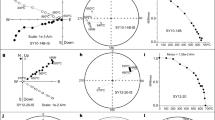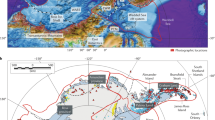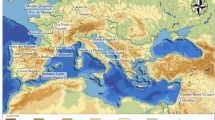Abstract
Palaeomagnetism shows the pattern of drift of Gondwanaland for the past 600 million years. There seem to have been at least four episodes of rapid drift, with little or no drift in between.
This is a preview of subscription content, access via your institution
Access options
Subscribe to this journal
Receive 51 print issues and online access
$199.00 per year
only $3.90 per issue
Buy this article
- Purchase on Springer Link
- Instant access to full article PDF
Prices may be subject to local taxes which are calculated during checkout
Similar content being viewed by others
References
Creer, K. M., Irving, E., and Runcorn, S. K., Phil. Trans. Roy. Soc., Lond, A, 250, 144 (1957).
Runcorn, S. K., Phil. Trans. Roy. Soc., Lond., A, 258, 1 (1965).
Collinson, D. W., and Runcorn, S. K., Bull. Geol. Soc. Amer., 71, 915 (1960).
Irving, E., Paleomagnetism and its Appfication to Geological and Geophysical Problems (J. Wiley and Sons, New York, 1964).
Irving, E., J. Geophys. Res., 71, 6025 (1966).
McElhinny, M. W., and Opdyke, N. D., J. Geophys. Res. (in the press).
Fisher, R. A., Proc. Roy. Soc., Lond., A, 217, 295 (1953).
Creer, K. M., Phil. Trans. Roy. Soc., Lond., A, 258, 27 (1965).
Kulp, J. L., Science, 133, 1105 (1961).
Pitman, W. C., and Heirtzler, J. R., Science, 154, 1164 (1966).
Vine, F. J., Science, 154, 1405 (1966).
Hess, H. H., in Petrologic Studies, a Volume in Honor of A. F. Buddington, 599 (Geol. Soc. Amer., 1962).
Dietz, R. S., Nature, 190, 854 (1961).
King, L. C., The Morphology of the Earth (Oliver and Boyd, Edinburgh, 1962).
de Toit, A. L., Our Wandering Continents (Oliver and Boyd, Edinburgh, 1937).
Creer, K. M., Nature, 204, 369 (1964).
Opdyke, N. D., J. Geophys. Res., 69, 2477 (1964).
Uffen, R. J., Nature, 198, 143 (1963).
Simpson, J. F., Bull. Geol. Soc. Amer., 77, 197 (1966).
Opdyke, N. D., Glass, B., Hays, J. D., and Foster, J., Science, 154, 349 (1966).
Irving, E., and Opdyks, N. D., Geophys. J., 9, 153 (1965).
Phillips, J. D., and Heroy, P. B., Trans. Amer. Geophys. Union, 47 (1), 80 (abstract) (1966).
Chamalaun, F. H., and Creer, K. M., J. Geophys. Res., 69, 1607 (1964).
Hide, R., Science, 157, 55 (1967).
Creer, K. M., Nature, 203, 1115 (1964).
Author information
Authors and Affiliations
Rights and permissions
About this article
Cite this article
BRIDEN, J. Recurrent Continental Drift of Gondwanaland. Nature 215, 1334–1339 (1967). https://doi.org/10.1038/2151334a0
Received:
Revised:
Issue Date:
DOI: https://doi.org/10.1038/2151334a0
This article is cited by
The continental drift debate
Nature (1977)
Palaeozoic and Mesozoic age trends for some ring complexes in Niger and Nigeria
Nature (1976)
Pulsation of tectonic phenomena and tectonophysical mechanisms
Geologische Rundschau (1975)
Orogenic zones in central Australia: intraplate tectonics?
Nature (1974)
Plate movement and continental magmatism
Nature (1974)
Comments
By submitting a comment you agree to abide by our Terms and Community Guidelines. If you find something abusive or that does not comply with our terms or guidelines please flag it as inappropriate.



